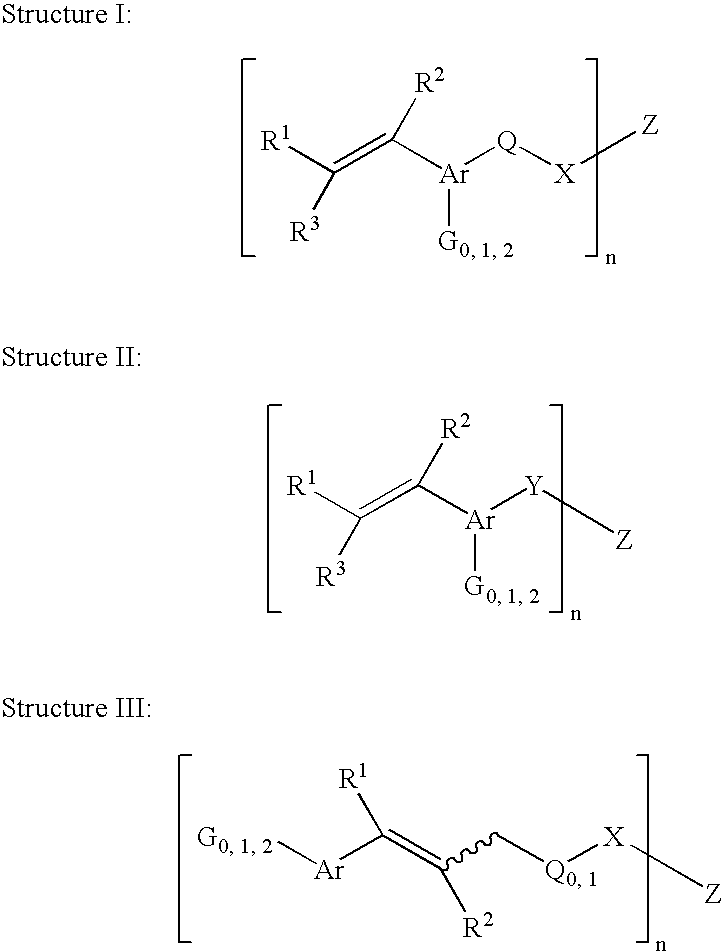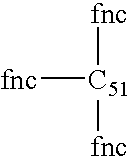Curable electron donor compositions
a technology of electron donor and composition, which is applied in the preparation of urea derivatives, group 4/14 element organic compounds, textiles and paper, etc., can solve the problem of limited number of suitable vinyl ether donors, and achieve the effects of increasing electron density, reducing reactivity, and increasing reactivity
- Summary
- Abstract
- Description
- Claims
- Application Information
AI Technical Summary
Benefits of technology
Problems solved by technology
Method used
Image
Examples
example 1
[0033]
[0034] 3-Isopropenyl-α,α-dimethylbenzyl isocyanate (m-TMI) (35.6 g, 0.177 mole) was solvated in toluene (100 g) in a 500 Ml three-necked flask equipped with a mechanical stirrer, addition funnel and nitrogen inlet / outlet. The reaction was placed under nitrogen, and 0.033 g of dibutyltin dilaurate (catalyst) was added with stirring as the solution was heated to 900 C. The addition funnel was charged with HO—C36—OH (50.12 g, 0.0884 mole) (Pripol 2033, Uniqema) dissolved in toluene (50 g). This solution was added to the isocyanate solution over ten minutes, and the resulting mixture heated for an additional three hours at 900 C. After the reaction was allowed to cool to room temperature, the mixture was washed with distilled water three times. The isolated organic layer was dried over MgSO4, filtered and the solvent removed in vacuo to give the product in 93% yield.
example 2
[0035]
[0036] OCN—C36—NCO (DDI 1410, Henkel) (98.79 g, 0.164 mole) was solvated in toluene (100 g) in a 500 mL three-necked flask equipped with a mechanical stirrer, addition funnel and nitrogen inlet / outlet. The reaction was placed under nitrogen, and 0.04 g of dibutyltin dilaurate (catalyst) was added with stirring as the solution was heated to 900 C. The addition funnel was charged with cinnamyl alcohol (44.01 g, 0.328 mole) dissolved in toluene (50 g). This solution was added to the isocyanate solution over ten minutes, and the resulting mixture was heated for an additional three hours at 900 C. After the reaction was allowed to cool to room temperature, the mixture was washed with distilled water three times. The isolated organic layer was dried over MgSO4, filtered and the solvent removed in vacuo to give the product in 94% yield.
example 3
[0037]
[0038] HO—C36—OH (Pripol 2033, Uniqema) (54.36 g, 0.096 mole), 50% NaOH (400 mL), tetrabutyl ammonium hydrogen sulfate (13.8 g, 0.041 mole), and cinnamyl chloride (33.69 g, 0.221 mole) in toluene were stirred for five hours at 530 C, then for 15 hours at 750 C. The reaction was allowed to cool to room temperature and the organic layer extracted and washed with brine three times. The isolated organic layer was dried over MgSO4, filtered and the solvent removed in vacuo to give the product in 95% yield.
PUM
| Property | Measurement | Unit |
|---|---|---|
| temperature | aaaaa | aaaaa |
| Tg | aaaaa | aaaaa |
| conductive | aaaaa | aaaaa |
Abstract
Description
Claims
Application Information
 Login to View More
Login to View More - R&D
- Intellectual Property
- Life Sciences
- Materials
- Tech Scout
- Unparalleled Data Quality
- Higher Quality Content
- 60% Fewer Hallucinations
Browse by: Latest US Patents, China's latest patents, Technical Efficacy Thesaurus, Application Domain, Technology Topic, Popular Technical Reports.
© 2025 PatSnap. All rights reserved.Legal|Privacy policy|Modern Slavery Act Transparency Statement|Sitemap|About US| Contact US: help@patsnap.com



